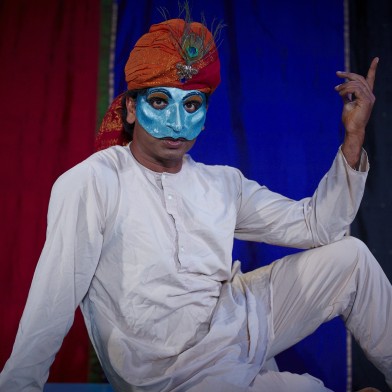Thousands of kilometres away from its place of origin in India, the ancient Indian dance form Bharatanatyam has found a home in New Zealand.
The Natraj School of Dance in Avalon, Lower Hutt has been a devoted custodian of this classical dance form for a quarter of a century. This New Zealand dance institution has become a gateway to Indian art and culture, welcoming individuals of all backgrounds, ages, and genders. Guided by director and founder Prabha Ravi, the school recently commemorated its 25th anniversary with a performance that effortlessly transcended boundaries.

Prabha Ravi, a passionate advocate for Indian classical dance and culture in New Zealand. Image: Sasi Harsha
Dance is a revered and ancient cultural tradition in India, where each movement tells a story passed down through generations. Among many Indian classical dance forms, Bharatanatyam stands as a pillar.
It’s believed to be the oldest dance form of them all and is often regarded as the mother of many. With its origins rooted in the sacred Hindu temples of Tamil Nadu, this art form thrived in the rich cultural tapestry of South India.
The very name Bharatanatyam carries a world of meaning, as it fuses two Sanskrit words: 'Natyam' for dance and 'Bharata,' a mnemonic encompassing 'Bha' for emotions, 'Ra' for melody, and 'Ta' for rhythm. In this fusion, Bharatanatyam becomes a beautiful dance that weaves together emotions, melody, and rhythm into a tapestry of artistic expression.
Natraj School of Dance celebrated its 25th anniversary earlier this year with its captivating production of Dasavatharam, depicting the 10 avatars of Lord Vishnu, a principal Hindu deity.
Lord Vishnu's avatars, crucial in Hindu mythology, symbolise his various incarnations for the restoration of cosmic order and the protection of dharma (righteousness). Each avatar has a unique story and purpose, making them a popular theme in various artistic and cultural expressions, including dance.

The Game of Dice: A rigged game in the Mahabharata that led to the Pandavas' exile and ignited the Kurukshetra War. Image: Sasi Harsha
Graduates and seasoned senior dancers from Natraj School of Dance guided the audience through a mesmerising spiritual journey, depicting the avatars and their respective eras according to the Hindu calendar. Each of the 10 avatars, with their unique significance, were portrayed gracefully: Matsya the fish, Kurma the tortoise, Varaha the boar, Narasimha the man-lion, Vamana the dwarf, Parashurama the warrior with an axe, Rama the prince of Ayodhya, Krishna the divine flute player, Buddha the enlightened one, and finally, Kalki the incarnation of eternity.
The dancers' facial expressions skillfully conveyed the vital Nava Rasas, or Nine Emotions integral to traditional Indian dance forms: love, laughter, compassion, anger, courage, fear, disgust, wonder, and peace. These nine emotions reflect the full spectrum of human expression and the dancers' movements beautifully conveyed these emotions, adding depth and meaning to the portrayal of the avatars.
What made this performance remarkable was its ability to reflect the modern world. It mirrored the turbulent era of Kaliyuga, often equated with today's age of downfall, and drew connections to pressing contemporary issues such as the climate crisis, warfare, and the lasting impact of the Covid-19 pandemic, all while grounding them in the wisdom of ancient Hindu scriptures.

Lord Krishna guides Arjuna onto the battlefield, preparing him for the challenges ahead. Image: Sasi Harsha
The performance encapsulated the belief that humanity awaits the arrival of the final incarnation of Lord Vishnu, Kalki, who will guide us out of today's tumultuous world. The Natraj School of Dance's presentation demonstrated how this ancient art form not only persists but also evolves, expertly blending tradition and innovation, all the while paying heartfelt homage to the divine.
Like other Indian classical dance forms, Bharatanatyam, a narrative-rich dance style, seamlessly integrates three key components: Nritta, which displays technical movements without explicit interpretation; Nritya, which delves into the realm of spirituality and conveys emotions through harmonious gestures; and Natya, which encompasses interpretive dance to portray character roles.
Prabha Ravi's choreography of the Dasavataram performance masterfully combined these elements, resulting in a captivating work of art on stage. The portrayal of Lord Vishnu in his full grandeur was nothing short of enthralling, underlining the importance of teamwork in the success of this production. The choreography and movements, coupled with the extensive stage utilisation, offered an enriching experience for all involved.
Before the Dasavatharam performance, the evening began with other Bharatanatyam dances like Mallari, which evoked the divine presence, and Dolayam, where the dancers showcased the various avatars of Lord Vishnu and welcomed Him in a palanquin.

Narasimha, Lord Vishnu's avatar as the man-lion, kills Hiranyakashipu, the tyrannical king who thought himself to be invincible. Image: Sasi Harsha
The entire evening felt like an enchanting journey through the pages of Hindu mythology, with the dancers skillfully narrating the tales.
This mystical journey also highlighted a fundamental aspect of dance—its ability to instill discipline.
Beyond the graceful movements and artistic expression, Indian classical dance imparts a deep sense of dedication and self-control. It demands rigorous practice, patience, and a profound connection with one's inner self, reflecting the spiritual discipline required to connect with the divine.
In the dancers' graceful movements and spiritual depth, we find a true celebration of India's rich cultural heritage. Prabha Ravi and her dedicated students have brought a piece of India to the heart of New Zealand, preserving a timeless tradition for the world to cherish.
- Asia Media Centre



